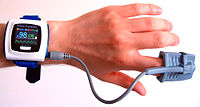
Predictors of in-laboratory polysomnography attendance in a cohort of patients with stroke or TIA.
Sign Up to like & getrecommendations! Published in 2019 at "Sleep medicine"
DOI: 10.1016/j.sleep.2019.10.002
Abstract: STUDY OBJECTIVES After cerebrovascular events, obstructive sleep apnea (OSA) is associated with poor functional outcomes, an increased risk of recurrent stroke, and mortality. Although the significant under-diagnosis of OSA is likely multifactorial in nature, factors… read more here.
Keywords: stroke tia; attendance; laboratory polysomnography; cohort patients ... See more keywords

Comparison of a home sleep test with in-laboratory polysomnography in the diagnosis of obstructive sleep apnea syndrome
Sign Up to like & getrecommendations! Published in 2022 at "Journal of the Chinese Medical Association"
DOI: 10.1097/jcma.0000000000000741
Abstract: Background: In-laboratory, polysomnography (PSG) is the gold standard for diagnosing obstructive sleep apnea syndrome (OSAS). However, the long waiting list and sleeping at a hospital make patients hesitate to undergo the examination, thereby delaying diagnosis.… read more here.
Keywords: laboratory polysomnography; diagnosis; accuracy; sleep apnea ... See more keywords

Impact of sleep chronotype on in-laboratory polysomnography parameters.
Sign Up to like & getrecommendations! Published in 2023 at "Journal of sleep research"
DOI: 10.1111/jsr.13922
Abstract: Morningness-eveningness preference, also known as chronotype, is the tendency for a person to sleep during certain hours of the day and is broadly categorised into morning and evening types. In-laboratory polysomnography (iPSG) is the gold-standard… read more here.
Keywords: ipsg; laboratory polysomnography; chronotype; physiology ... See more keywords